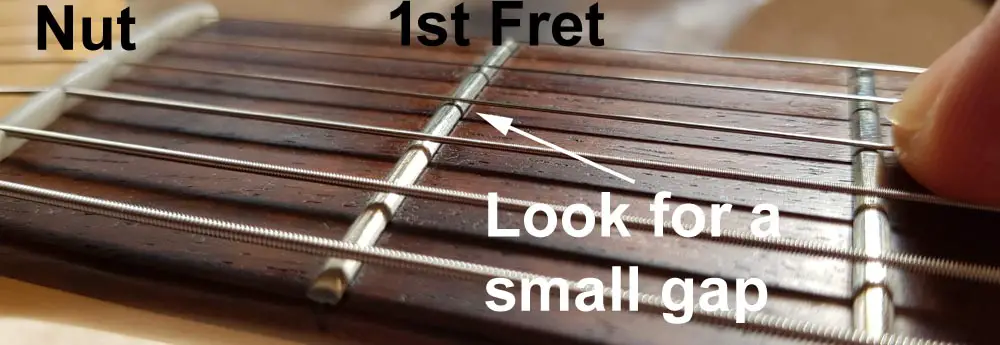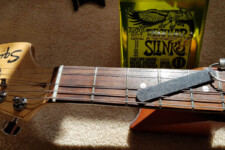5 Ways To Fix Fret Buzz After Changing Strings
Changing your guitar strings can be one of the most gratifying experiences as a guitarist.
Your fingers instinctively know when it’s time to move on, and changing strings is like a breath of fresh air for your fingers, and breathes new life into your guitar’s sound.
Unfortunately, there is also that other side to the joy as well. Changing strings can be frustrating because it can cause fret (or string) buzz.
This article will focus on 5 ways you can fix fret buzz after changing your strings.

Is Fret Buzz Normal After Changing Strings?
If you’re more experienced with changing your guitar strings and maintaining your guitar, then chances are you won’t get any fret buzz, and should just be able to enjoy the sound of your new strings.
Fret buzz is not something you should normally expect when changing your strings with the same gauge and brand. Buzzing could be due to a change of string gauges, or an adjustment needed that was hidden with the old dull strings.
Having a guitar set with a low action will increase the chances that a string change will cause buzzing, but usually it’s easy and quick to fix.
Sometimes if you’ve gone from a very old set of strings to new ones they could buzz a little on the frets during the initial playing-in stage.
Let’s go into a bit more detail about how you can fix new string fret buzz.
1. Check the String Gauge and Type
Did you change the strings for the same gauge as the old strings?
Sometimes this is hard to know unless you know the original gauge the guitar came with, or put the last set on yourself. If you have a set of calipers you could go as far as measuring the old strings.
If your new strings are a heavier gauge you are unlikely to get extra fret buzz, but if you have fitted a lighter set there could be some adjustments needed on your guitar. I’ll talk more about this below.
Also you can get slightly different tension strings when using different types of strings. This can occur because of changes in the core of the string (inside the outer winding).
So even if you have used the same gauge, you may find another brand will be a little different, and some strings also feel softer to play, meaning they could move more when vibrating and cause some fret buzz.
2. Check the Nut
Lighter strings are obviously a bit thinner, and this means they could sit a little lower in the nut slots or rattle around in the old slots made for the larger strings. This rattle in the nut slot is not visible, but can make a string sound like it’s buzzing on a fret.
If you’re now getting fret buzz at the first fret, then your nut may need to be raised, the slots filled and filed again, or just replace the nut completely (usually the best option).
One quick way to check for the correct nut slot height is to hold each string at the third fret, and check that there is a small gap between the string and first fret. If any of the strings touches the fret, then you will get fret buzz when you play open strings.

3. Adjust the Neck Relief
Lighter strings have less tension, and this can mean the truss rod is pulling the neck backwards too much which makes the neck too straight. This can cause buzzing around the center of the neck.
To check the neck relief, put a capo on the first fret, and hold the low E string down at a high fret, and you should see a gap at the 8th fret large enough for a business card between the string and the fret.
Make sure you hold the guitar in the playing position when you check this, and the strings are tuned up to pitch.
If the gap is too small, then use a tool to loosen the truss rod slightly. Just note that the neck may further settle over the next day.
If you took off the old strings and left your guitar unstrung for a week or more, your neck may have shifted a little, so allow some settling time when you tune back up with the new strings.
4. Check the Bridge or Saddle Height
This is easily done on an electric guitar as there are screws that allow you to easily change the height of the strings.
If your nut and neck relief are set correctly and you are still getting fret buzz with your new strings, then possibly the action is set too low at the bridge.
Acoustic guitars are harder to adjust, and a saddle that is too low will need to be replaced with a new saddle.
Different playing styles can dictate slightly different action settings for your bridge, so the following is just a rough guide.
- The average acoustic guitar is set up with 0.10” (2.5mm) action on the low E string at the 12th fret, and 0.08” (2mm) for the high E string.
- An average electric guitar is set up with 0.09” (2.3mm) action on the low E string at the 12th fret, and 0.06” (1.6mm) for the high E string.
The harder you strum or pick the strings, the more they vibrate and the more likely they are to cause fret buzz with low action.
5. Check for High Frets
If you’re still getting fret buzz with your new strings after checking the previous issue, then it’s possible that you have a worn fret or high fret.
Sometimes fitting a new set of strings settles your neck slightly different to before, and there may have been a fret that was on the verge of causing buzzing that is now clearly heard.
New strings can have more treble when new, and you could even find a little fret buzz will disappear as the string tone evens out with some playing.
If buzzing is only heard at one or two places on the neck, check if the crown of the next lowest fret appears worn down flat.
You can also use a fret rocker to see if you have uneven frets at that point.
Sometimes you can file a fret slightly to fix the problem, but otherwise you may need a guitar tech to do a fret level and dress to get your guitar sounding great again.




